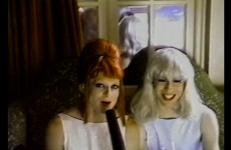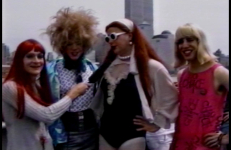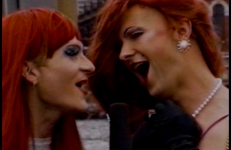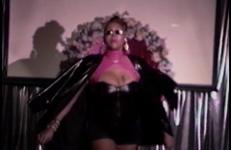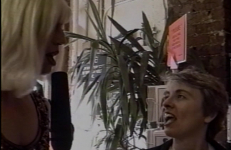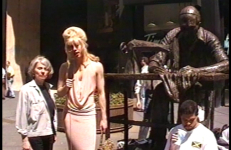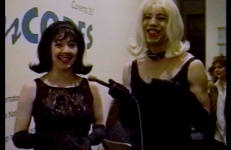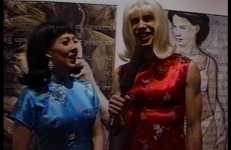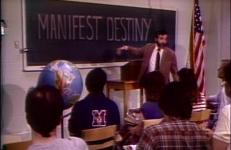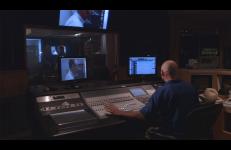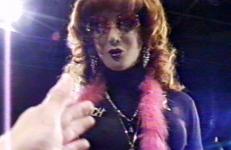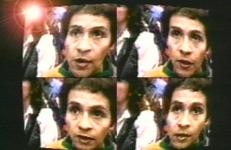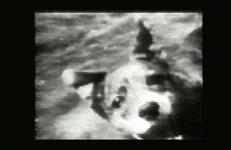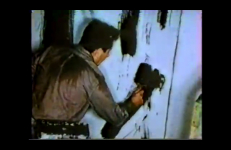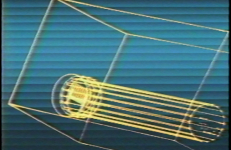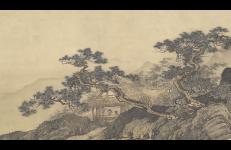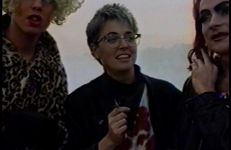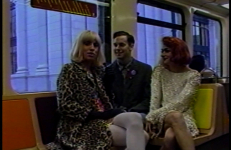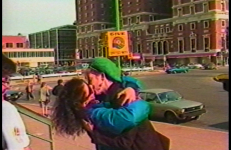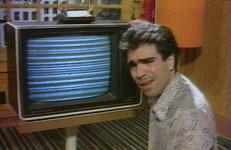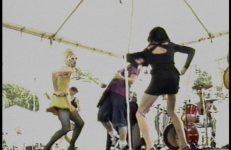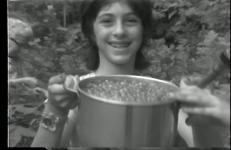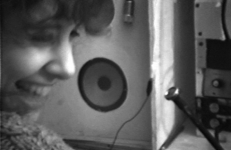In From Fagtasia to Frisco, Brenda and Glennda report from Fagtasia, an event honoring the Summer Solstice in New York organized by the Radical Faeries. Through interviews with Faeries and footage of their walk across the Brooklyn Bridge, the group proposes to reclaim the city as a safe space for queer people, and discuss reorienting queer consciousness toward spirituality.
Television
This two-part video Gender Cruise on the Circle Line involves Brenda and Glennda leading a group of drag queens, drag kings, and other gender nonconforming people on a three-hour ride on the Circle Line boat around Manhattan.
The two-part video Gender Cruise on the Circle Line involves Brenda and Glennda leading a group of drag queens, drag kings, and other gender nonconforming people on a three-hour ride on the Circle Line boat around Manhattan.
In Glennda and Bruce Do Times Square, Glennda is taken on a night tour of Times Square by author Bruce Benderson. They observe the dynamic between forms of culture that would typically be identified as “underclass” in “suburbanite” culture within the economic and spatial landscape of New York City. Glennda and Bruce visit the apartment of performer Consuela Cosmetic, who was prolific within New York’s ball scene. She maps out the ways in which she believes gender can be expressed, and discusses the implications of ‘passing’.
In this video, Glennda Orgasm and social critic Camille Paglia walk the streets of downtown Manhattan and discuss the status of mainstream feminism in the early 1990s. They visit the Stonewall Inn, Washington Square Park, and a gay bookstore, and confront a group of anti-pornography protesters.
An episode of Glennda and Friends, hosted by Glennda Orgasm and Camille Paglia. Featuring The Centaurians, Brian Roach, and Rennard Snowden.
In this video, Glennda is joined by social critic and feminist scholar Camille Paglia in New York's fashion district. The pair visit designers studios to discuss their respective styles and creative processes. Additionally, Glennda and Camille explore fashion's relationship to gender and feminism, ultimately recreating an iconic scene from Breakfast at Tiffany's.
An episode of Glennda and Friends, hosted by Glennda Orgasm and Camille Paglia.
In this video, Glennda and sex activist Chris Teen attend the opening of Dress Codes at Boston's Institute of Contemporary Art. They interview museum staff, artists, and other attendees to explore how an exhibition centered upon gender nonconformity will be received by both queer communities and the general public. Glennda and Chris Teen discuss the importance of visibility for marginalized communities, and tap into gender discourses as they existed in the early 1990s.
In this video, Glennda Orgasm and Chris Teen travel to Washington, DC to attend a feminist art exhibition titled Walk the Goddess Walk at the District of Columbia Arts Center. The pair talk to the owner of the gallery, artists included in the show, and attendees, including Francy Caprino, Teena Cromwell, Andrew Melon, Camille Paglia, and Joseph Virgilio.
An episode of Glennda and Friends, hosted by Glennda Orgasm and Chris Teen.
In this video, Glennda and Judy LaBruce (Bruce LaBruce) visit the auction house Christie's East on New York's Upper East Side to view Judy Garland memorabilia that is being auctioned off. They attempt to rescue Garland's Oscar from those trying to profit from the auction.
An episode of Glennda and Friends, hosted by Glennda Orgasm and Judy LaBruce.
In the video Glennda does DC, Glennda interviews people in Washington D.C. about the topic of gay rights. As the National Gay and Lesbian Task Force Conference is going on simaltaneously, she asks people if they were aware of this, and if they believe that there should be a gay rights bill.
Smith’s gentle, recusant comedy is a critique of masculine domination, focusing on the myth of manifest destiny. Believing the moral of the Old West that “Everything is there for the taking”, mild-mannered Mike is inspired to “Go for it!" and conquer wide-open spaces in the modern way: as a real estate developer of suburban sub-divisions. Dressed as a cowboy and mime-riding a horse in front of images of mobile homes, Smith updates the notion of “rugged individualism” to include personal theme music and a chorus.
A single-shot, choreographed portrait of the Foley* process, revealing multiple layers of fabrication and imposition. The circular camera path moves inside and back out of a Foley stage in Burbank, California. While portraying sound artists at work, typically invisible support mechanisms of filmmaking are exposed, as are, by extension and quotation, governmental violations of individual privacy.
George Kuchar just received a tape of himself on the Dog and His Friends from the Dog House television show, but he must first track down a VHS player to watch it. After arriving at a friend’s home, Kuchar draws attention to the number of animals present in the kitchen, noting that it reminded him of the Playboy Mansion in Chicago, Illinois. Flashing back to Chicago, Kuchar takes a tour of the abandoned ‘pleasure palace’ by flashlight, exploring the dark recesses of the basement bowling alley and underwater bar.
As sad as it can be to be trapped in a TV show, singing words you don't even know the meaning of.
This title is also available on Ximena Cuevas: El Mundo del Silencio (The Silent World) and Half-Lies: The Videoworks of Ximena Cuevas.
Gibbons presents a Son of Sam-like relationship between a man and his dog in which the man takes the dog to task for the terrible things he has made him do. Shot in Pixelvision.
This title is also available on Joe Gibbons Videoworks: Volume 1.
“Hey, how’s that TV work?”
The idea of suspension is evoked on shifting registers – as levitation, cessation, preservation, and suspense – and located in sites whose identities slip as we track through a space within a space.
Camera, Edit, Sound Design: Deborah Stratman
Scroll: T’ang Yin
Dolly: Matthew Thompson
In the Queen City is a series of three videos shot in Buffalo, New York that were produced following an invitation from Hallwalls Contemporary Art Center as part of their Ways In Being Gay festival.
An episode of The Brenda and Glennda Show, hosted by Brenda Sexual and Glennda Orgasm. Production Support Provided by Hallwalls Contemporary Art Center.
In the Queen City is a series of three videos shot in Buffalo, New York that were produced following an invitation from Hallwalls Contemporary Art Center as part of their Ways In Being Gay festival.
An episode of The Brenda and Glennda Show, hosted by Brenda Sexual and Glennda Orgasm. Production Support Provided by Hallwalls Contemporary Art Center.
In the Queen City is a series of three videos shot in Buffalo, New York that were produced following an invitation from Hallwalls Contemporary Art Center as part of their Ways In Being Gay festival.
An episode of The Brenda and Glennda Show, hosted by Brenda Sexual and Glennda Orgasm. Production Support Provided by Hallwalls Contemporary Art Center.
Tapping into cable because of his lousy reception, Mike gets more than he bargained for as he unwittingly becomes trapped in the medium—the “star” of his own cable TV show. Due to an incomprehensible mishap, Mike’s rewired TV now transmits his image to the world; the observer has become the observed. Turning the tables on viewership in a way that reflects the banality of television, Smith touches on identification with television, and the manner in which television re-presents our world back to us.
In this video, Glennda Orgasm and Jackie Offie attend Lollapalooza '95 on Randall's Island, New York. Glennda and Jackie sing punk rock songs on the drag stage, and Glennda challenges Courtney Love to a fistfight. The video also shows other performances on the stage, and features Bruce LaBruce's music video for The Riverdales' Fun Tonight.
“Trolling for news we call it,” says Bart Friedman a minute into this video, as he pushes down a road the Lanesville TV News Buggy – a baby carriage filled with video equipment, spilling over with wires. The buggy allows for easy transportation of equipment as the Videofreex make their way throughout Lanesville, interviewing residents on their daily activity. Although fairly ordinary – a visit to the lake, a small bit about a neighbor’s new electric golf cart, and an introduction to a newborn baby – the footage has an air of genuineness and all of the interactions are amicable.
"Between March 1972 and February 1977, the Videofreex aired 258 television broadcasts from a home-built studio and jerry-rigged transmitter in an old boarding house they rented in the tiny Catskill Mountain hamlet of Lanesville. It was a revolutionary act in defiance of FCC regulations — the first unlicensed TV station in America."




